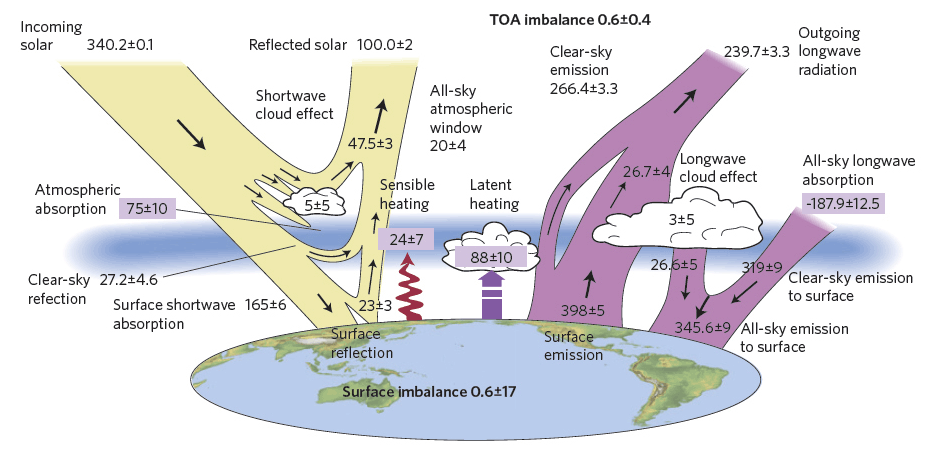What's the Deal about "Global" Temperatures? This.
The temperature for the "Global" oceans is very consistent even with the buckets and intakes dust up. According to the data, the average global ocean temperature is about 18.05 C for the temperature record that exists. Hadley and NCDC have the two major products for the longest time frame. They are almost interchangeable, (+/- about 0.1C). If you avoid the extreme poles where ocean and land can be confused due to sea ice that is fast or persistent, you have the most reliable reference for "global" temperatures.
If you use "global" land temperature you have a larger spread. The average for these two shots is 11 C with a range of about +/-2.5 C. With an 11 C mean you have roughly an energy equivalent of 370 Wm-2 +/-13 Wm-2. Land is only about 30% of the surface of the Earth so land contributes about 110 Wm-2 to the Earth energy budget with a range of +/-3.95 Wm-2 uncertainty. Oceans contribute about 285 Wm-2, ignoring latent energy, +/-0.17 Wm-2 uncertainty. So using the data I used, the average temperature of the Earth is about 15.6 C with an energy of 396 Wm-2 +/-about 4.12 Wm-2 excluding latent.
You can compare my estimate with Stephens et al. 2012 which shows 398 Wm-2 +/-5 Wm-2 for the radiant portion and add about +/-12 Wm-2 for the latent uncertainty. Not bad for a Redneck guestimate.
This is the real world of thermodynamics. It is better to completely ignore land which has an uncertainty equal to the forcing change anticipated and work with the real oceans, the liquid part from about 60S to 60N. Any time one of the warmunist minions mention, "But da Land!!" think about this post instead of trying to argue with them.
If you forget, the minions will break out nice charts of "global" temperature anomalies that mask uncertainty by well, ignoring it. If you just show them the Stephens et al. 2012 graphic, they will never get past the 0.6 +/-0.4 at the Top of the Atmosphere which is in the ballpark of other computer modeled TOA estimates like say the K&T 0.9 +/- a ridiculous 0.18 Wm-2.
Arguing with them about "global" land temperature anomaly adjustments is also a waste of time and energy. Baselining anomaly ignores uncertainty so all "adjustments" are trivial or minor with respect.
If you do wander into the adjustment debate, this is the main issue, coastal smearing.
This compares the Berkeley Earth land temperature data which is long range interpolated via kriging with ERSSTv4 ocean and Hadley's Climate Research Unit's Land temperature with its HADI ocean temperature data. Berkeley has a better correlation with ocean than CRUT Ts which does not try to interpolate long range. Any long range interpolation scheme, i.e. Berkeley, GISS 1200 km and Hadley with the Cowtan and Way kriging will smear coastal and in some cases ocean temperature into their land "only" products. That is fine for some applications, not so great for others. Land tree ring temperature reconstruction calibration would be one of those "others".
Update: After correcting a few minor typos remember this, Never trust a Redneck, all the data used is on climate explorer except the "global" actual land temperature in C for Berkeley which is at Berkeley Earth. Try it yerself.
Mo' update: If Berkeley Earth were to produce a "global" land and ocean actual temperature data product the "global" average temperature for 1854 to 2014 should be about 15.18 C +/- 0.09 C using their method. Cowtan and Way ltd should produce one as well and if it isn't 15.18 +/- 0.09 C, someone screwed up. That is how you compare temperature reconstructions.
Should they produce a real temperature data set, then the model mean actual temperature becomes a sore thumb since it is about 13.8C or off by 1.4 C / 7.4 Wm-2 lower than the best estimate of "actual". Climate science is truly comical at times.
UPDATE. Global "surface" temperature is a combination of sea surface temperature and the average of Tmax and Tmin for land surface stations. I have been mainly looking at modeled SST in the tropical regions for another puzzle, but I thought I would make a model combined global surface temperature using tos, Temperature Ocean Surface and tas, Temperature Air Surface with the CMIP5 model means.
Using this combination, the models run a little cold initially and catch up. Remember that the Berkeley/ERSSTv4 combination is just my estimate of actual global surface temperatures. There isn't an "official" Global Surface Temperature product, just anomaly products.
In the tropics (20S-20N) the model mean for tos runs a tad warm compared to ERSSTv4 and in other comparisons it can be a lot warmer which I will save for another post.
The interesting things is despite the regional issues, combining 70% tos with 30% tas produces a fairly good match at close to 288 K ( 14.85 C degrees) even though there has been a number of history revisionists wanting to change "normal" to about 287K or 14 C degrees.
Looking at the "projection" from this point of view you end up with an equilibrium climate sensitivity of about 1.7C using the models and about 1.6 C using instrumental.







No comments:
Post a Comment